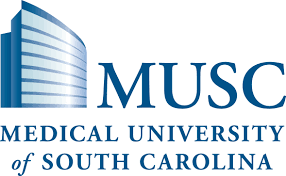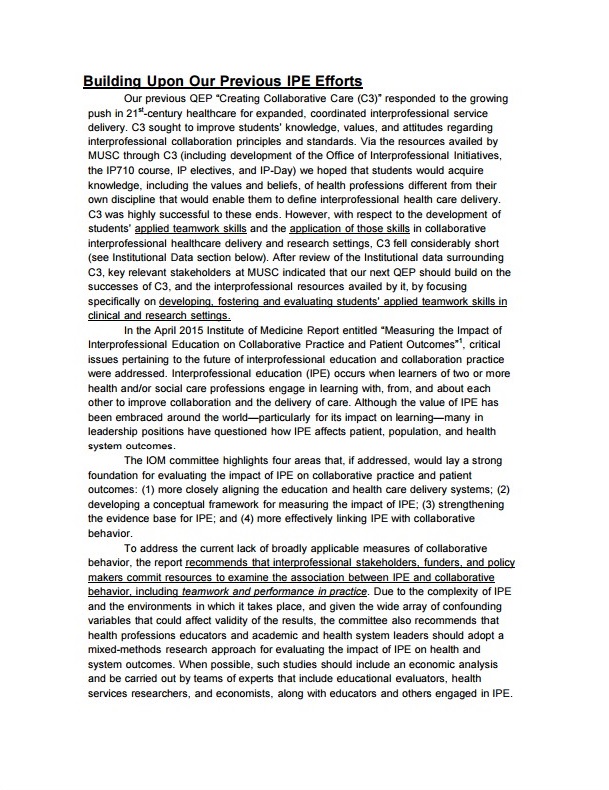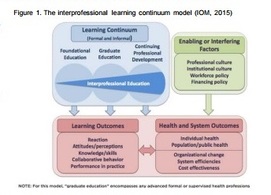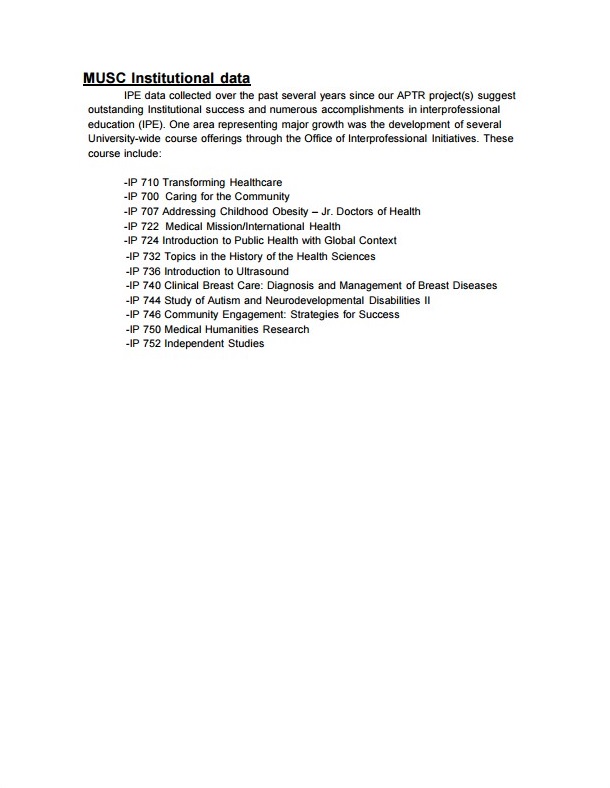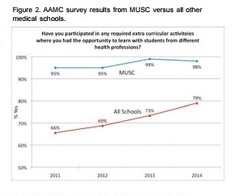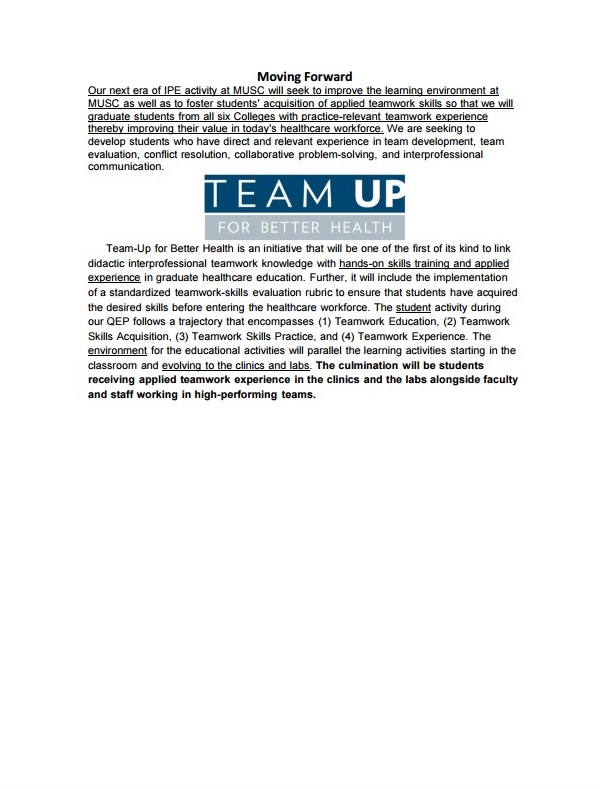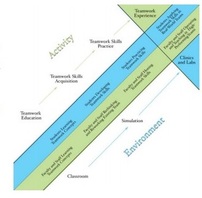In order to provide the best possible health care, health professionals need to understand and apply prevention and population health principles, practice in interprofessional teams, and effectively connect with other health services. In order to provide effective interprofessional team-based care, students need access to the right knowledge, skills and attitudes. At the Medical University of South Carolina, we have sought to incorporate the APTR Healthy People Curriculum Task Force recommendations across all of our educational programs.
We actively:
1) Incorporate clinical prevention and population health educational content in their curricula;
2) Evaluate students’ knowledge and skills with regard to clinical prevention and population health;
3) Monitor license and certification requirements for all of our clinical programs;
4) Use diverse teaching and learning methods to incorporate clinical prevention and population health content into degree and continuing education programs, including service-learning, problem/case-based learning, and simulationmethods; and
5) Integrate innovative, interprofessional educational experiences and approaches focused on clinical prevention and population health
Through this subaward project, we gathered data on translation of classroom instruction into applied skills, student perceptions of interprofessional activities at MUSC, and evaluation of novel IPE technologies we have recently developed. We include quantitative and qualitative data on the administrative structure, educational resources and institutional support for IPPE since our original APTR project in 2008. We report on number of students served, number of education programs participating in the activities, program capacities, and topic areas covered in the IPPE curriculum.
We actively:
1) Incorporate clinical prevention and population health educational content in their curricula;
2) Evaluate students’ knowledge and skills with regard to clinical prevention and population health;
3) Monitor license and certification requirements for all of our clinical programs;
4) Use diverse teaching and learning methods to incorporate clinical prevention and population health content into degree and continuing education programs, including service-learning, problem/case-based learning, and simulationmethods; and
5) Integrate innovative, interprofessional educational experiences and approaches focused on clinical prevention and population health
Through this subaward project, we gathered data on translation of classroom instruction into applied skills, student perceptions of interprofessional activities at MUSC, and evaluation of novel IPE technologies we have recently developed. We include quantitative and qualitative data on the administrative structure, educational resources and institutional support for IPPE since our original APTR project in 2008. We report on number of students served, number of education programs participating in the activities, program capacities, and topic areas covered in the IPPE curriculum.
Impact
|
Created Office of IPE Initiatives, Assistant Provost and Advisory Council for IPE. |
IPE programming reaches all ~760 health professions students and involves 150 faculty across 6 colleges. |
IPE curriculum and service learning address childhood obesity prevention and oral health. |
APTR Project Proposal 2007/2008 IPE Institute Project
|
Our original IPPE projects entailed two major themes. One was “Developing an Interprofessional Community Health Prevention Learning Project (faculty participants Donna Kern, MD, Amy V. Blue, PhD, Mary Hewett, MS, PA-C, Andrea White, PhD, Marilyn King, DNSc, RN, Sarah Shrader, Pharm D.), and the other was “Developing an Interprofessional Oral Health Prevention Curriculum” (faculty participants Wanda Gonsalves, MD, Paul Jacques, DHSc, PA-C, Lisa Summerlin, MA, RDH). The goals of these projects were to provide health professions students (Colleges of Pharmacy, Medicine,
|
Sustained the post-institute IPE activity or project after the initial year of implementation: No, but alternative IPE programs were developed soon after |
Dental Medicine, Nursing, and Health Professions-Physician Assistant and Health Administration programs) with an interprofessional learning experience designed to increase knowledge and skills in interprofessional community health care collaboration.
These learning experiences introduced students to a collaborative approach to health promotion/disease prevention focusing on:
- Childhood Obesity Prevention
- Oral Health
This initiative was called the Interprofessional Service Learning Program (ISLP). The specific learning objectives for students were to:
- Recognize the value of interprofessional health care collaboration
- Discuss the value of a community health approach to healthcare and prevention, including work with community groups
- Participate in interprofessional community health service learning projects
- Recognize sociocultural elements relevant to community and individual health
- Discuss ways to address youth obesity through nutrition and physical fitness
- Introduce students to oral health and associated prevention issues
Current ipe activity/project description
MUSC has institutionalized interprofessional education initiatives via the creation of the Office of Interprofessional Initiatives. This Office is led by the Assistant Provost for Interprofessional Initiatives, and is operated by a board of several Associate Directions including:
- Director of Operations
- Associate Director for Education
- Associate Director for Research
- Associate Director for Mentoring and Faculty Development
- Associate Director for Collaborative Practice
- Associate Director for Hospital Integration
- Associate Director for Community Affairs and AHEC
Structural Dimension:
The Office of Interprofessional initiatives (OII) serves as the backbone/structure for all IPE activities at MUSC. The Office appoints curriculum committees for several IP courses and we are working to standardize metrics of interprofessional teamwork skills (for students, faculty and staff) across IP activities as part of the strategic plan and QEP for SACS-COC.
The Office of Interprofessional initiatives (OII) serves as the backbone/structure for all IPE activities at MUSC. The Office appoints curriculum committees for several IP courses and we are working to standardize metrics of interprofessional teamwork skills (for students, faculty and staff) across IP activities as part of the strategic plan and QEP for SACS-COC.
Human Dimensions:
OII works with MUSC Medical Center’s Chief Learning Officer to develop educational resources for all MUSC faculty and staff, and OII manages educational resource development for all IPE activities that involve students. The IPID Advisory Council, OII Directors, IPSAB and OII staff steer all of the IP activities at MUSC together.
OII works with MUSC Medical Center’s Chief Learning Officer to develop educational resources for all MUSC faculty and staff, and OII manages educational resource development for all IPE activities that involve students. The IPID Advisory Council, OII Directors, IPSAB and OII staff steer all of the IP activities at MUSC together.
Political Dimensions:
The integration of IPE into MUSC’s strategic plan and SACS-COC accreditation process has resulted in maintenance of IPE as an Institutional priority since the original APTR project. This has also ensured adequate financial and resource commitment from the institution as accreditation and strategic plan-success are high priorities.
The integration of IPE into MUSC’s strategic plan and SACS-COC accreditation process has resulted in maintenance of IPE as an Institutional priority since the original APTR project. This has also ensured adequate financial and resource commitment from the institution as accreditation and strategic plan-success are high priorities.
Symbolic Dimensions:
Overall Institutional faculty engagement has been good, as we engage over 150 faculty members from all 6 MUSC Colleges in IPE teaching, precepting and supervisory activities each year. Further, faculty, students and staff throughout the entire institution generate scholarly works (papers, presentations, and posters) to highlight our IPE efforts.
Overall Institutional faculty engagement has been good, as we engage over 150 faculty members from all 6 MUSC Colleges in IPE teaching, precepting and supervisory activities each year. Further, faculty, students and staff throughout the entire institution generate scholarly works (papers, presentations, and posters) to highlight our IPE efforts.
IPE OFFERINGS INCLUDE:
- IPE Courses
- IPE Clinical Rotations or Clerkships
- IPE Fellowships
- IPE Community Projects/ Service Learning
- IPE Standardized Assessment or Evaluation
- IPE Extra-Curricular Activities
|
ACADEMIC LEVELS TARGETED:
|
COURSE DESCRIPTION:
|
|
PLACEMENT SITES FOR ANY SERVICE-LEARNING COMPONENTS:
|
EVALUATION METHODS USED FOR THE SUBGRANT PROJECT:
|
Lessons/results/outcomes
Evaluation Results:
Despite our IPE efforts, students did not report developing relevant, applied, teamwork skills through IP initiatives. This has prompted a re-vamping of our IP activities in alignment with our QEP to ensure that IPE activities yield tangible skills for our future healthcare workforce. (Check Resources)
Despite our IPE efforts, students did not report developing relevant, applied, teamwork skills through IP initiatives. This has prompted a re-vamping of our IP activities in alignment with our QEP to ensure that IPE activities yield tangible skills for our future healthcare workforce. (Check Resources)

